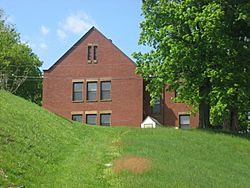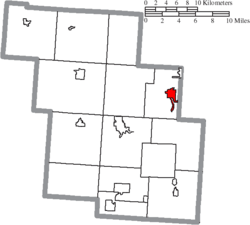Crooksville, Ohio facts for kids
Quick facts for kids
Crooksville, Ohio
|
|
|---|---|
|
Village
|
|

Crooksville's historic West School
|
|
| Nicknames:
"The Clay City of Perry County", "Potteryland USA"
|
|

Location of Crooksville, Ohio
|
|

Location of Crooksville in Perry County
|
|
| Country | United States |
| State | Ohio |
| County | Perry |
| Area | |
| • Total | 1.65 sq mi (4.26 km2) |
| • Land | 1.62 sq mi (4.20 km2) |
| • Water | 0.02 sq mi (0.06 km2) |
| Elevation | 771 ft (235 m) |
| Population
(2020)
|
|
| • Total | 2,418 |
| • Estimate
(2023)
|
2,402 |
| • Density | 1,489.83/sq mi (575.11/km2) |
| Time zone | UTC-5 (Eastern (EST)) |
| • Summer (DST) | UTC-4 (EDT) |
| ZIP code |
43731
|
| Area code(s) | 740 |
| FIPS code | 39-19456 |
| GNIS feature ID | 2398654 |
Crooksville is a small village located in Perry County, Ohio, in the United States. It sits right next to Moxahala Creek. In 2020, about 2,418 people lived there. Crooksville was once famous for Hull pottery, which was one of Ohio's most well-known pottery makers.
Contents
History of Crooksville
Crooksville was officially started around 1874. This happened because the U.S. Postal Service agreed to a request from its founders, Jacob Reed and Joseph Crooks. The village has grown and changed a lot over the past 126 years. It is located off State Route 93 in Perry County. The people of Crooksville have always worked hard to make it a good place for families and businesses.
Early Beginnings and Jacob Reed
Between 1820 and 1825, a young man named Jacob Reed came from the East. He was looking for a good place to invest his money. On his journey, he met his future wife, Lydia. Together, they found the heavily forested land that is now Crooksville.
Reed bought a piece of land along the Moxahala Creek from the government. He even had a special paper signed by President James Monroe. He started his business with a lumber mill and a farm. The money he earned helped him buy more land. Soon, he owned between 300 and 400 acres.
The Railroad and Pottery
In 1856, a railroad line was built through Reed's farm. This railroad connected the towns of Zanesville and New Lexington. Jacob Reed made a deal with the railroad company. Because of this, a special side track was built on his property. He built a warehouse there for his grain, and it was called Reed Station. The local freight train also had a passenger car. It would stop there to pick up and drop off people.
Around this time, more farms appeared near Reed's land. Most of these farms had a small kiln. A kiln is a special oven used for baking clay to make pottery. These kilns were usually in small, unheated buildings. This meant pottery could only be made from spring to fall. This led to the nickname "bluebird potteries." They would start making pottery in the spring when bluebirds returned. They would stop when the bluebirds flew south for winter.
How Crooksville Got Its Name
The area grew, and more people moved in. This created a need for building materials, shops, churches, and schools. The land was not only good for farming but also had lots of clay and coal. This helped the pottery and coal mining industries grow strong.
In 1870, Joseph Crooks bought a small piece of land near the railroad. He opened a general store there. At that time, the closest post offices were in McCluney and Roseville. There was no mail delivery route through the area. Someone would usually visit the post office once a week. They would bring back mail for their neighbors too.
Because of this, Joseph Crooks started a petition. He wanted to ask the government to set up a post office in the area. He hoped it would be called "Reeds Post Office." He also asked to be the Postmaster. The Post Office Department in Washington agreed to open a post office and make Crooks the Postmaster. However, they said there was already a "Reeds Post Office" in Ohio. So, they suggested the new office be called "Crooksville." Joseph Crooks liked this idea.
By 1894, about 800 people lived in Crooksville. The residents then took steps to make it an official village.
Geography
Crooksville is a small village. It covers about 1.64 square miles (4.26 square kilometers) in total. Most of this area, about 1.62 square miles (4.20 square kilometers), is land. A very small part, about 0.02 square miles (0.06 square kilometers), is water.
Population Information
| Historical population | |||
|---|---|---|---|
| Census | Pop. | %± | |
| 1900 | 835 | — | |
| 1910 | 3,028 | 262.6% | |
| 1920 | 3,311 | 9.3% | |
| 1930 | 3,251 | −1.8% | |
| 1940 | 2,890 | −11.1% | |
| 1950 | 2,960 | 2.4% | |
| 1960 | 2,958 | −0.1% | |
| 1970 | 2,828 | −4.4% | |
| 1980 | 2,766 | −2.2% | |
| 1990 | 2,601 | −6.0% | |
| 2000 | 2,483 | −4.5% | |
| 2010 | 2,534 | 2.1% | |
| 2020 | 2,418 | −4.6% | |
| 2023 (est.) | 2,402 | −5.2% | |
| U.S. Decennial Census | |||
How Many People Live Here?
As of the census in 2010, there were 2,534 people living in Crooksville. These people lived in 977 households, and 651 of these were families. The village had about 1,564 people per square mile.
About 29.7% of the people living in the village were under 18 years old. About 12.8% were 65 years old or older. The population was almost evenly split between males (48.1%) and females (51.9%).
Arts and Culture
Every year in mid-July, Crooksville and its nearby village of Roseville hold a special event. It's called the Crooksville-Roseville Pottery Festival. This festival celebrates everything about pottery. You can learn about how pottery is made, how it's designed, and how people collect it.
Education
The Crooksville Exempted Village School District runs the schools in the area. This includes an elementary school, a middle school, and Crooksville High School.
Crooksville also has a public library. It is a branch of the Perry County District Library, where you can borrow books and learn new things.
Famous People from Crooksville
- Rollo Walter Brown, a writer and teacher
- Ronald E. Rosser, who received the Medal of Honor for his bravery
See also
 In Spanish: Crooksville (Ohio) para niños
In Spanish: Crooksville (Ohio) para niños

